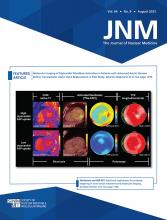TO THE EDITOR: Since the large-scale deployment of coronavirus disease 2019 vaccination, several publications have mentioned many false-positive findings on PET examinations, mainly with 18F-FDG but also with other radiopharmaceuticals (1). For instance, Notohamiprodjo et al. recently reported that the prevalence of vaccine-associated lymphadenopathy (VAL) on 18F-rhPSMA-7.3 PET/CT was high, at 45% (2), but some points of the study deserve comment.
First, the authors stated that “increased ipsilateral axillary uptake of [prostate-specific membrane antigen (PSMA)] ligand is common” but omitted to mention some contradictory results in the literature. In fact, we prospectively constituted a cohort in which 120 and 79 patients underwent 18F-fluorocholine or 68Ga-PSMA-11 PET/CT, respectively, and we reported a 42.5% incidence of VAL for 18F-fluorocholine PET/CT (which was comparable to the findings with 18F-FDG) but only a 12% incidence for 68Ga-PSMA-11 PET/CT (3). This difference cannot be due entirely to variable definitions of VAL between studies but may be explained by differences in the studied populations or in the radiopharmaceutical itself (4).
Second, the authors did not provide a documented hypothesis explaining the false-positive cases. A possible explanation comes from PSMA uptake in the context of neoangiogenesis (5). We hypothesized that coronavirus disease 2019 vaccination could induce production of vascular cell adhesion molecules and vascular endothelial growth factor, as observed during severe acute respiratory syndrome coronavirus 2 infection (6), leading to neovasculature and therefore PSMA uptake.
Third, as mentioned by the authors, “separate analysis among those vaccines was not performed.” Nevertheless, differences between vaccines could be expected since a metaanalysis found VAL more frequently after the Moderna vaccine than after the Pfizer-BioNTech vaccine (7), whereas a comparative study reported higher metabolic activity in the lymph nodes after Pfizer-BioNTech than after AstraZeneca (8).
Last, the authors do not suggest a clear management plan for these lymph nodes in clinical practice. Should they be closely monitored for development or regression by physical examination or by imaging? Should they be systematically analyzed by a pathologist? Some researchers are exploring ways to address this issue. For instance, radiomics could help differentiate VAL from malignant lymphadenopathies (9). Besides, innovative radiopharmaceuticals are under development and capable of overcoming postvaccination pitfalls, such as use of the 68Ga-fibroblast-activation protein inhibitor, which showed no fixation in postvaccination axillary nodes, to replace 18F-FDG (10).
In conclusion, the study provides valuable information about false-positive cases on PET imaging due to vaccination—a recurrent issue that needs to be addressed, even if some results can be challenged by other existing findings, notably in our work published previously. However, this study has the merit of reminding the imaging interpreter and the prescriber that PSMA ligand is not specific to prostate cancer and not even to the prostatic gland.
Loic Ah-Thiane*, Ludovic Ferrer, Caroline Rousseau
*ICO René Gauducheau St-Herblain, France
E-mail: loic.ah-thiane{at}ico.unicancer.fr
ACKNOWLEDGMENTS
We would like to thank the French National Agency for Research (Investissements d’Avenir), LabexIRON no. ANR-11-LABX-0018-01 and EquipexArronaxPlus no. ANR-11-EQPX-0004, for their support.
Footnotes
Published online Jun. 22, 2023.
- © 2023 by the Society of Nuclear Medicine and Molecular Imaging.
REFERENCES
- Received for publication March 30, 2023.
- Revision received April 14, 2023.







